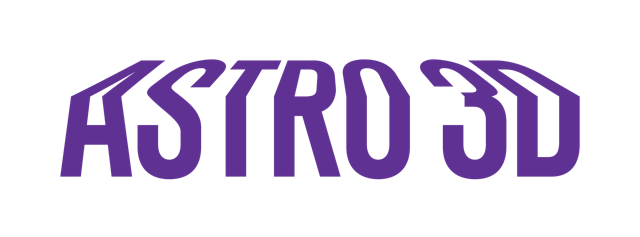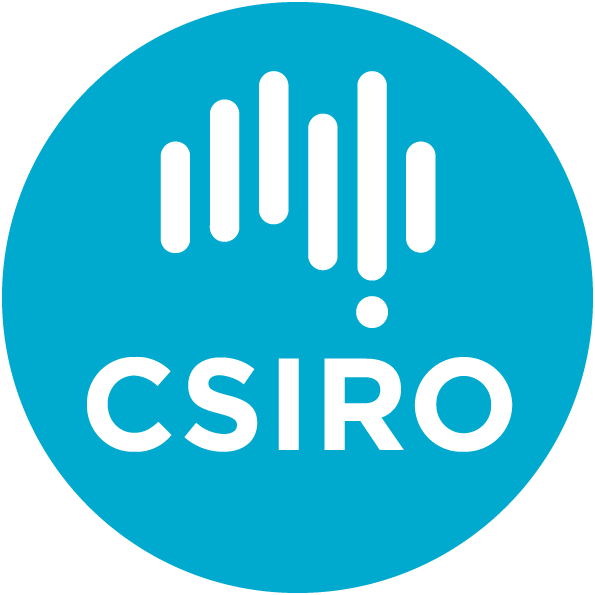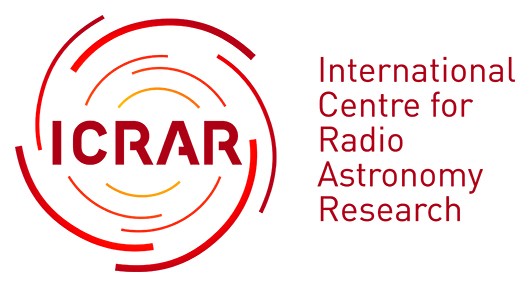August 2020
Editor: Tristan Reynolds
Foreword
Tristan Reynolds
Welcome to the August 2020 edition of the WALLABY newsletter. I have taken over from Ivy as editor and would like to thank Ivy for her time as editor. Much has happened since the last newsletter at the start of this year both for the WALLABY survey and the wider world. I hope this newsletter finds everyone well in this COVID-19 world.
In this issue, we have an update on the latest pilot ASKAP observations and reports from several technical working groups. Chandra provides an update of his work on the Eridanus pre-pilot field and Garima highlights the main results from her paper looking at the HI-halo mass relation using simulations. We also have updates from Technical Working Groups 1, 3, 4, 5 and 7 and Science Working Groups 1, 2 and 5. Happy reading!
Message from the WALLABY PI
Lister Staveley-Smith
A lot seems to have happened in the WALLABY world since the last newsletter. But firstly let me thank Ivy Wong for her editorship of previous newsletters and to Tristan Reynolds for taking on the task from this newsletter onwards. Also, congratulations to Tristan and Ahmed Elagali for the successful defence of their WALLABY-related PhD theses! A number of important milestones have been achieved by our team recently, some of which are documented below. But I’ll just pick out two highlights: namely the internal DR1 release in April of a subset of post-processed data from the Hydra pilot field (accompanied by a public release of the ‘raw’ data cube); and the acceptance for publication of the WALLABY overview paper. Congratulations to everybody involved!
Message from the project manager
Tobias Westmeier
With the pilot survey in full swing, the WALLABY project has entered a new era in which we have access to actual HI data at the nominal resolution and sensitivity for the first time. All three pilot survey fields in the direction of Hydra, NGC 4636 and Norma have been fully observed at this stage, and the Hydra field has already been calibrated and imaged, leading to the first internal release of data for almost 150 HI detections in the direction of the Hydra cluster earlier this year. Our science teams are currently busy analysing the Hydra DR1 data, and first science papers are expected to be submitted soon.
During the first week of March we had a very productive WALLABY busy week in Perth that was attended by approximately 20 team members (including a few remote participants). The main aim of the busy week was to assess the technical readiness of the WALLABY project in light of the pilot survey currently under way. The busy week was a great success in bringing the relevant people together to discuss our current progress in various technical and organisational areas (ranging from kinematics modelling to simulations and data archiving) and to agree on the next steps on our way towards implementing the full WALLABY survey.
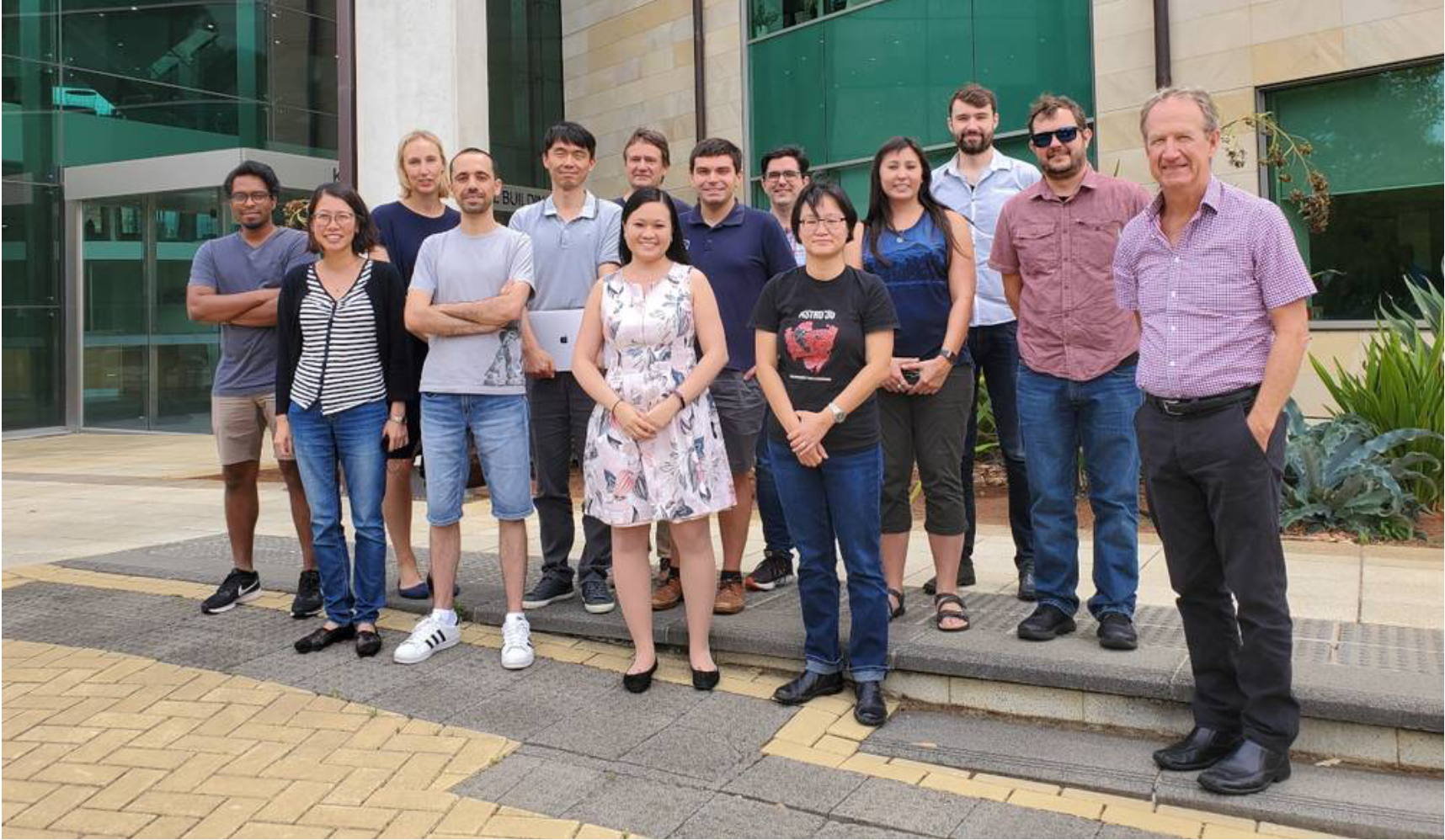
Just in time for the first pilot data to be processed, we have reopened the internal submission process for pilot survey science papers to allow team members to propose additional science projects that are not yet covered by any of the existing proposals. New proposals will be reviewed individually and, once approved, be added to the list of approved projects on our Redmine wiki. At the time of writing, three additional proposals have already been accepted, including a proposal to study the HI content of the satellite populations of Milky Way analogues in the three WALLABY pilot fields and two proposals to investigate signs of gas stripping in two galaxies detected in the Hydra field.
Message from the project scientist
Karen Lee-Waddell
With the first round of ASKAP pilot surveys officially completed mid-May, ASKAP is currently in a “consolidation phase” intended to prioritize upgrades and maintenance over conducting science observations.
A second round of pilot survey observations should begin later this year with the primary goal of establishing commensality between the various ASKAP survey science projects. There has been a lot of discussion between the science teams on the matter and potential observing strategies will continue to develop, particularly during the ASKAP pilot phase 2 workshop that will take place later this month.
Meanwhile, WALLABY members are busy validating and analysing the Hydra DR1 data products (please refer to the update from TWG3 for more details). It is really exciting to see some of the new science results that are starting to come out of just a small subset of the WALLABY pilot survey observations.
On a more personal note, I have recently been appointed as the first Director of the Australian SKA Regional Centre (https://aussrc.org). In this role, I will be leading the Australian effort to design and build computing and data intensive research capability that will support astronomers using SKA precursors (such as ASKAP and the MWA) and eventually the SKA. The position itself is quite flexible and with a common goal of helping to usher in the future of radio astronomy, I plan to continue as the Project Scientist for WALLABY and actively contribute to the collaboration.
Angular Momentum Properties of the Eridanus Galaxies: An Update on the Eridanus Pre-Pilot Work
by Chandrashekar Murugeshan
In this work we make use of the pre-pilot observations of the Eridanus supergroup, to study the angular momentum and HI properties of the Eridanus galaxies. We have modelled 42 extended galaxies (of the 50 odd detections in the field) using the 3D kinematic fitting code 3DBarolo (Di Teodoro & Fraternali 2015), and have derived robust rotation curves. Using the HI moment 0 maps and 2MASS Ks-band mosaics of the galaxies, we have computed their HI (MHI), stellar (Mstar) and total baryonic (Mb) masses. Following this, using the derived rotation curves, the total specific baryonic angular momentum (jb) has been computed for the 42 galaxies. The results indicate that the jb values of the Eridanus galaxies are consistent with what is expected for their Mb. However, we find that the Eridanus galaxies are significantly HI-deficient for their Mb and jb values, as indicated by their deviation from the fatm – q relation (Obreschkow et al. 2016). Here, fatm is the atomic gas fraction, and q is the integrated disk stability parameter proportional to jb / Mb. The q parameter has been shown to regulate the HI-gas fraction (fatm) in local star forming galaxies. Any deviation from the fatm – q relation thus hints at external/environmental processes that may be affecting the HI gas fractions of galaxies. The fact that we observe Eridanus galaxies drifting below the fatm – q relation is suggestive that tidal and/or ram pressure stripping may be playing important roles in making galaxies in the Eridanus group HI-deficient. The results of this work are expected to be submitted as an early science paper soon. Stay tuned!
The Physical Drivers of the HI-Halo Mass Relation
by Garima Chauhan
In the quest to understand the HI-Halo mass (HIHM) scaling relation, we use the state-of-the-art semi-analytic galaxy formation model, SHARK, to investigate the physical processes involved in dictating the shape, scatter and evolution of the HIHM relation from 0 < z < 2. Unlike the stellar-halo mass, the HIHM relation is not necessarily monotonic and is characterised by a large scatter. We compared the HIHM relation of SHARK with available observation, finding agreement with the HI stacking results for Mvir < 1012 M☉ and Mvir > 1013.3 M☉, though SHARK under-predicts in the range 1012-1013.3 M☉. We find the discrepancies are largely due to the uncertainty in group definitions around that halo mass (Chauhan et al in prep). In SHARK, we find that the HI mass increases with the halo mass up to a critical mass of ~ 1011.8 M☉; between ~ 1011.8 M☉ and 1013 M☉, the scatter of the relation increases and the HI mass decreases with the halo mass on average (till Mvir ~ 1012.5 M☉, after which it starts increasing); and at Mvir > 1013 M☉, HI continues to increase with increasing halo mass, as a result of the increasing HI contribution from satellite galaxies. We find that the peak of the HIHM relation at Mvir ~ 1012 M☉ is set by feedback from Active Galactic Nuclei (AGN), and the exact shape and scatter of the relation is extremely sensitive to how AGN feedback is modelled. We also determine the main secondary parameters responsible for the scatter of the HIHM relation, namely halo spin-parameter at Mvir < 1011.8 M☉, and the fractional contribution from substructure to the total halo mass for Mvir > 1013 M☉. Using this knowledge we present a numerical model to populate dark matter-only simulations with HI at 0 < z < 2 based solely on halo parameters that are measurable in such simulations, making them useful for survey design (see Figure 2).
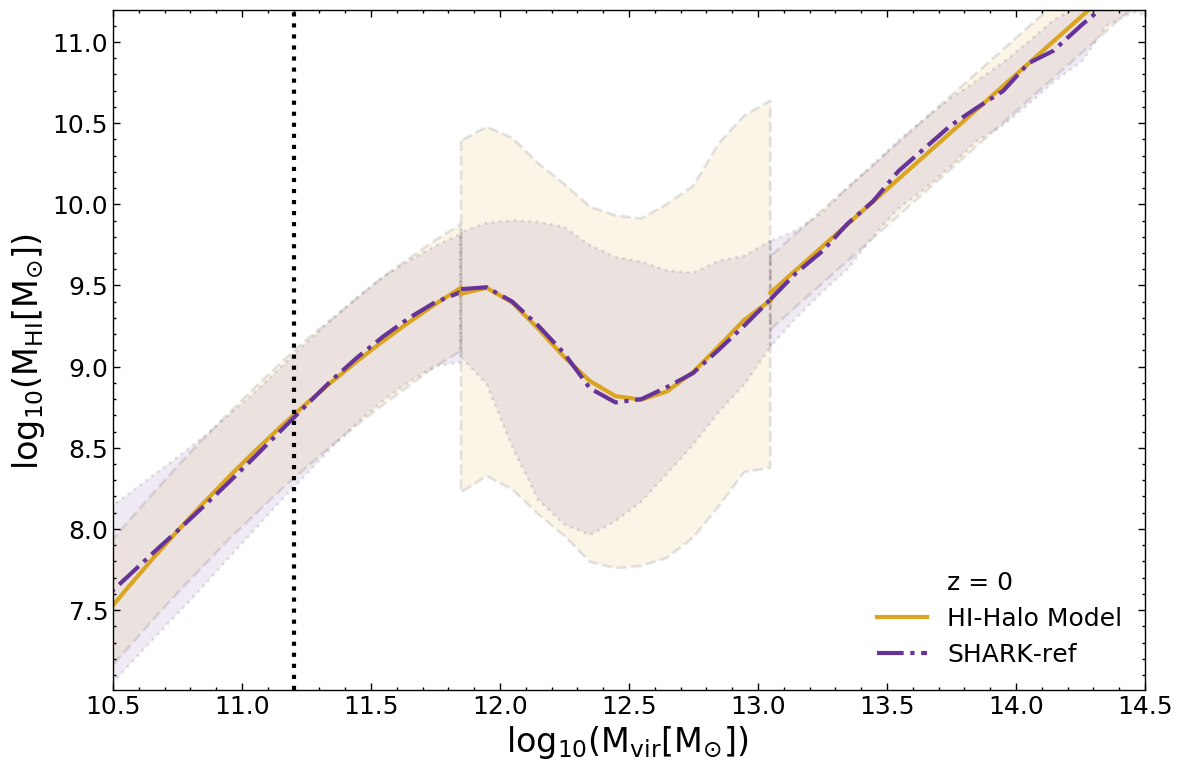
TWG 1 – Numerical Simulations and Mock Surveys
by Adam Stevens
Well, it’s been a — hmm — interesting year. And while many astronomical facilities have been affected by the pandemic, us theorists have persisted with our laptops at hand. In particular, our PhD students have produced new predictions that Wallaby will be able to test. At ICRAR, Garima Chauhan released a paper (arXiv:2006.12102) looking at the relationship between the HI mass of haloes and their total-matter mass using the Shark semi-analytic model. Her work shows how significant AGN feedback is for the HI content of Milky Way-mass haloes and above, and compares against other simulations and current observational results. Also at ICRAR, Adam Watts has been investigating the effect that environment has on asymmetries in HI line profiles with IllustrisTNG. Both papers have been submitted to MNRAS. Both the angular resolution and number of detected systems that Wallaby will achieve will prove informative when compared with these works as to whether current galaxy formation models are successfully capturing the detailed influences that galaxy environment has on HI.
Several Wallaby members, including two from TWG1, were also involved in a collaborative paper led by Romeel Davé, published in MNRAS (arXiv:2002.07226). This paper provides a broad comparison of the HI and H2 content of galaxies predicted by the foremost cosmological hydrodynamic simulations (IllustrisTNG, Simba, and EAGLE) alongside the best survey data to date. This should prove a highly useful resource for anyone seeking to find out what model predictions surrounding HI in galaxies look like from the current state of the art.
Another great piece of news to come out of 2020 was Swinburne’s transition to purchasing renewable energy for its campus operations. This includes the OzSTAR supercomputer, meaning it has now become a “Green machine” (which, funnily enough, was the name of its predecessor). While this is only one of many supercomputers that we rely on (and others still generally come with a hefty carbon footprint — arXiv:1912.05834), this is an important and necessary step in the right direction. Decarbonizing our research, especially when it comes to large-scale projects like ASKAP and the SKA, has to be a priority.
A reminder to all team members that the simulations used in the Wallaby overview paper (hooray for this being published!) are available. Contact me for access.
TWG 3 – Data Processing, Imaging and Quality Control
by Karen Lee-Waddell
After the initial release of the Hydra pilot survey data products (DR1), we have been working with the ASKAPsoft team to adjust/improve the pipeline in order to address our data quality concerns, as detailed in the table below:
Concern/Issue |
Progress being made |
Deployed in pipeline |
|---|---|---|
| Ability to excise spurious signals in specific beams for certain antennas | User-defined flagging specifications can be read and applied by the ASKAPsoft flagger | Yes |
| Continuum subtraction | After numerous tests, uv-based continuum subtraction using the CleanModel followed by image-based subtraction of residuals appears to be the best method to proceed | Yes |
| Milky Way HI emission being flagged out | Using similar parameters to ASKAP processing, we are able to process and image Galactic HI (see SWG1 update); however, a second run of the pipeline, on a limited bandwidth range is required | Yes |
| Flux discrepancy of partially/non-deconvolved sources | Preliminary tests of a feature enabling a variable taper to achieve a fixed PSF across the bandwidth of the image cube is showing significant promise and should remedy some of the missing flux issues |
Yes, more versatility to be added |
| Incorrect primary beam offset during postage stamp imaging | A bug that was essentially ignoring a line in the parameter file has been fixed | Yes, needs testing |
The next releases of ASKAPsoft should include updates to address all the aforementioned issues and concerns. Assuming that the initial pipeline processing tests go well, we should be ready for the ASKAP operations team to re-process the pilot data for the Hydra field.
Recently, CASDA added functionality that enables validation reports to be easily viewed online, so users can quickly determine data quality before downloading anything. To test this feature, the remaining files for the individual interleaves of the Eridanus pre-pilot observations were uploaded onto CASDA. With a complete set of data products and validation reports, the Eridanus data have now been released as “level 6” to the general public (project code AS035).
The next step will be to upload the corresponding validation reports for the Hydra DR1 pilot survey data. Thanks to Bi-Qing For, these reports will have a few new metrics, such as beam-by-beam antenna flagging statistics. There are on-going efforts to improve the expected RMS metric as well as incorporate other validation parameters that have been suggested by the wider ASKAP spectral line teams.
TWG 4 – Source Finding and Cataloguing
by Tobias Westmeier on behalf of TWG 4
SoFiA 2
With support from AusSRC and ADACS, we have successfully multi-threaded and parallelised the SoFiA 2 source finding pipeline over the past 6 months. The most time-consuming algorithms are now multi-threaded using OpenMP. This will reduce the execution time of the source finding pipeline by typically a factor of a few on machines with multiple CPU cores and even on basic laptop computers with just 4 or 8 cores. In addition, a parallel wrapper around SoFiA 2 has been developed by Dave Pallot and Slava Kitaeff as part of the AusSRC support project for WALLABY. This new wrapper, called SoFiA-X, allows users to spawn multiple parallel instances of SoFiA 2 on different computing nodes using the Slurm Workload Manager. Each instance can be made to process a separate subregion of a large data cube, and the results from each instance will be copied into a database for further processing. SoFiA-X is also capable of automatically identifying and merging duplicate detections that could arise from areas of overlap between adjacent subregions.
With the multi-threading and parallelisation work complete, we are now in the fortunate position to be able to run SoFiA 2 on a full-scale WALLABY data cube in an amount of time that is solely limited by the available computing resources and I/O speed. As an example, it took us just 7 minutes to process a 12.9 GB test data cube on a single node and 24 CPUs of the computing cluster at ICRAR (Figure 3), corresponding to a processing rate of more than 100 GB/h. At that speed, just 4 nodes would be sufficient for processing an entire WALLABY footprint across 144 MHz of bandwidth in 1 hour, while 12 nodes would decrease the overall processing time to just 20 minutes.
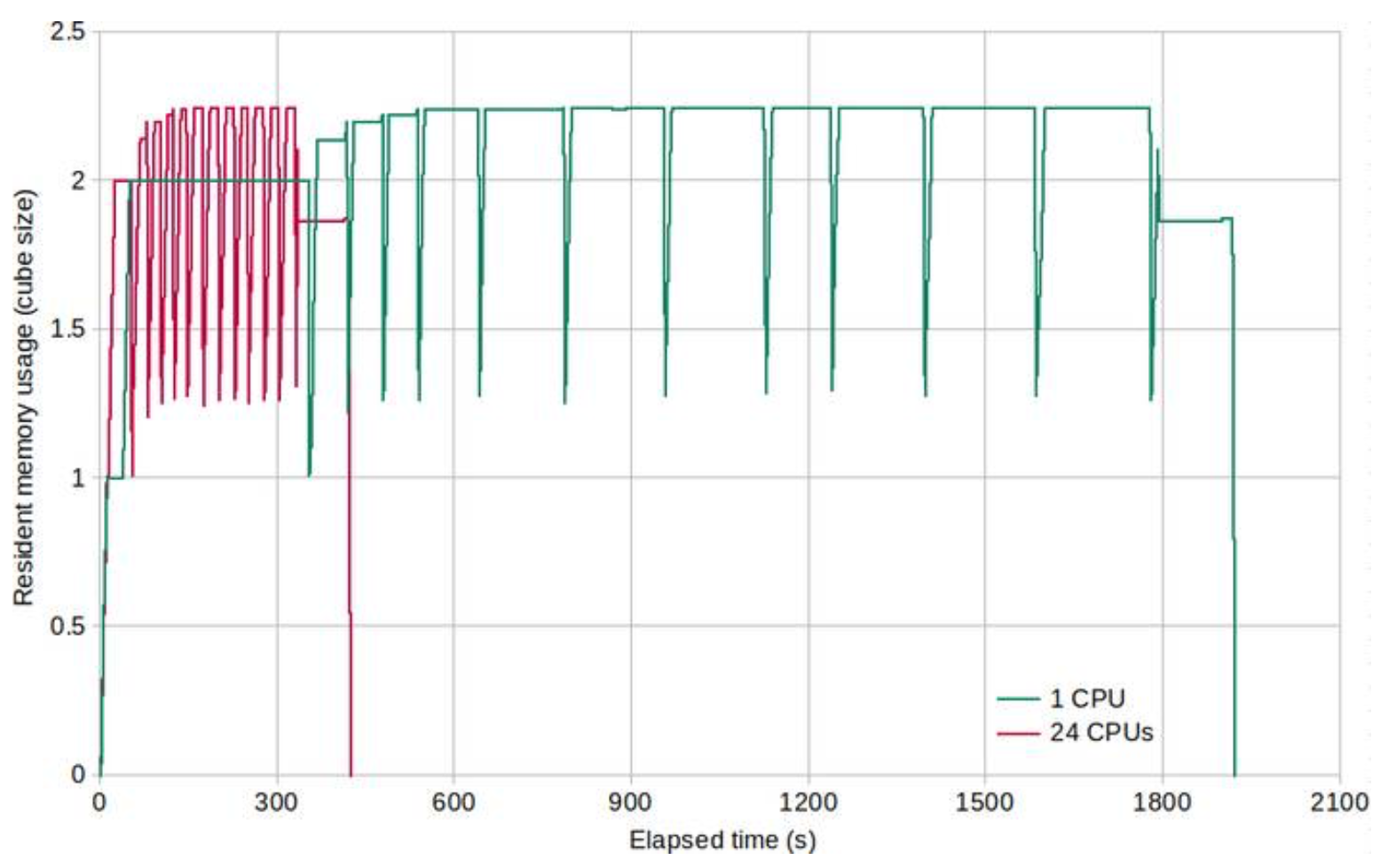
The latest and fully multi-threaded release, SoFiA 2.2, is available for download from GitHub at https://github.com/SoFiA-Admin/SoFiA-2/ while the parallel SoFiA-X framework can be downloaded separately from https://github.com/AusSRC/SoFiA-X/.
Hydra DR1
We successfully ran SoFiA 2 on the first WALLABY pilot survey data in the direction of the Eridanus galaxy cluster to produce the source catalogue for the first internal release of pilot data to the WALLABY team. For this purpose, we selected a relatively clean part of the full Hydra mosaic centred on the Hydra cluster itself. The processed region covers about 3.0° × 5.5° on the sky out to a redshift of 0.05, amounting to about 85 GB of data.
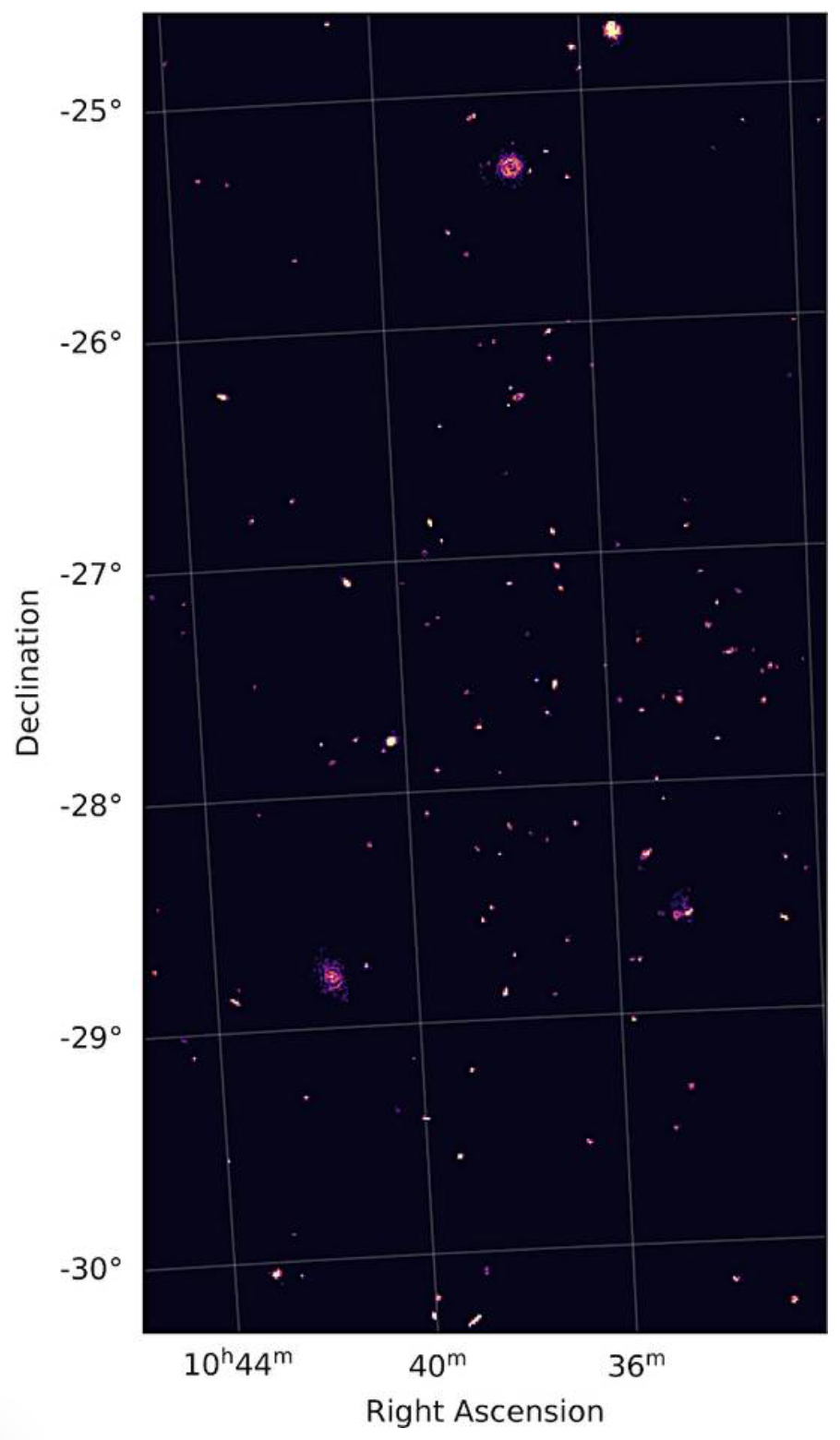
SoFiA 2 completed the source finding run in approximately 2 hours (running 4 instances in parallel, but with multi-threading not yet available) on the Hyades computing cluster at ICRAR. After manual removal of a few artefacts caused by flagging and continuum subtraction issues in the data reduction pipeline, 148 detections remain. The resulting catalogue and individual source data products produced by SoFiA 2 were passed on to the pilot survey science teams for scientific analysis.
The global moment 0 map of the Hydra DR1 detections is shown in Figure 4. In addition to numerous faint and compact sources, several well-resolved spiral galaxies are visible. Being a blind survey, a significant fraction of WALLABY detections are close to the detection threshold of about 5σ and so faint that their emission is well below the noise level at the native resolution of the data.
The successful source finding run for Hydra DR1 demonstrates that we are able to extract a highly complete and reliable source catalogue from large WALLABY data cubes. Attempts to reprocess the Hydra data are under way and expected to improve the flagging and continuum subtraction to the point that the manual removal of artefacts will no longer be necessary.
TWG 5 – Kinematics Pipeline
by Kristine Spekkens
Modelling Hydra DR1 Detections
Over the past few months, the focus of Technical Working Group 5 (TWG 5) has been the generation of kinematic models of resolved Hydra DR1 Pilot Survey detections in order to test modelling techniques and enable science by WALLABY members. TWG 5 has identified 22 sources that are amenable to kinematic modelling, and the approach is to use existing 2D and 3D algorithms to fit rotating disk models to their HI morphologies and kinematics. These kinematic models are complemented by photometric models of GALEX NUV and PanSTARRS optical imaging also being carried out within TWG 5.
Almost all resolved Hydra DR1 detections fall into a spatial resolution and signal-to-noise regime in which standard modelling codes have not been validated: recent work has therefore focussed on determining which parameters can be reliably recovered and used for science. Happily, early TWG 5 results suggest that galaxies that are spatially resolved by as few as 2-3 beams across the major axis may be modellable to some degree. This implies that the number of WALLABY detections for which the disk structure can be constrained could be significantly higher than previously predicted using a 5-beam threshold (e.g. Koribalski et al. 2020, Ap&SS, 365, 118).
Of the 22 potentially modellable Hydra DR1 detections, TWG 5 has converged on the three most promising objects for detailed code tests given their large angular sizes, favourable sky projections and degree of regularity (see Figure 5): ESO 501−75, NGC 3313, and ESO 437−4. Careful comparisons between 3D models generated by the 3DBarolo (Di Teodoro & Fraternali 2015, MNRAS, 451, 3021) and FAT (Kamphuis et al. 2015, MNRAS, 452, 3139) algorithms have demonstrated that modelling uncertainties are predominantly systematics associated with the adopted modelling approach, while 2D models generated by BAYGAUD+2DBAT (Oh et al. 2019, MNRAS, 485, 5021; Oh et al. 2018, MNRAS, 473, 3256) may provide useful geometrical constraints. These tests also suggest that, while the rotation curve and disk geometry can be reliably constrained, velocity dispersions are likely beyond the reach of these models. Differences in modelling approach between 3DBarolo and FAT also imply that surface density distributions are highly model-dependent, with the appropriate choice likely depending on the science goal.
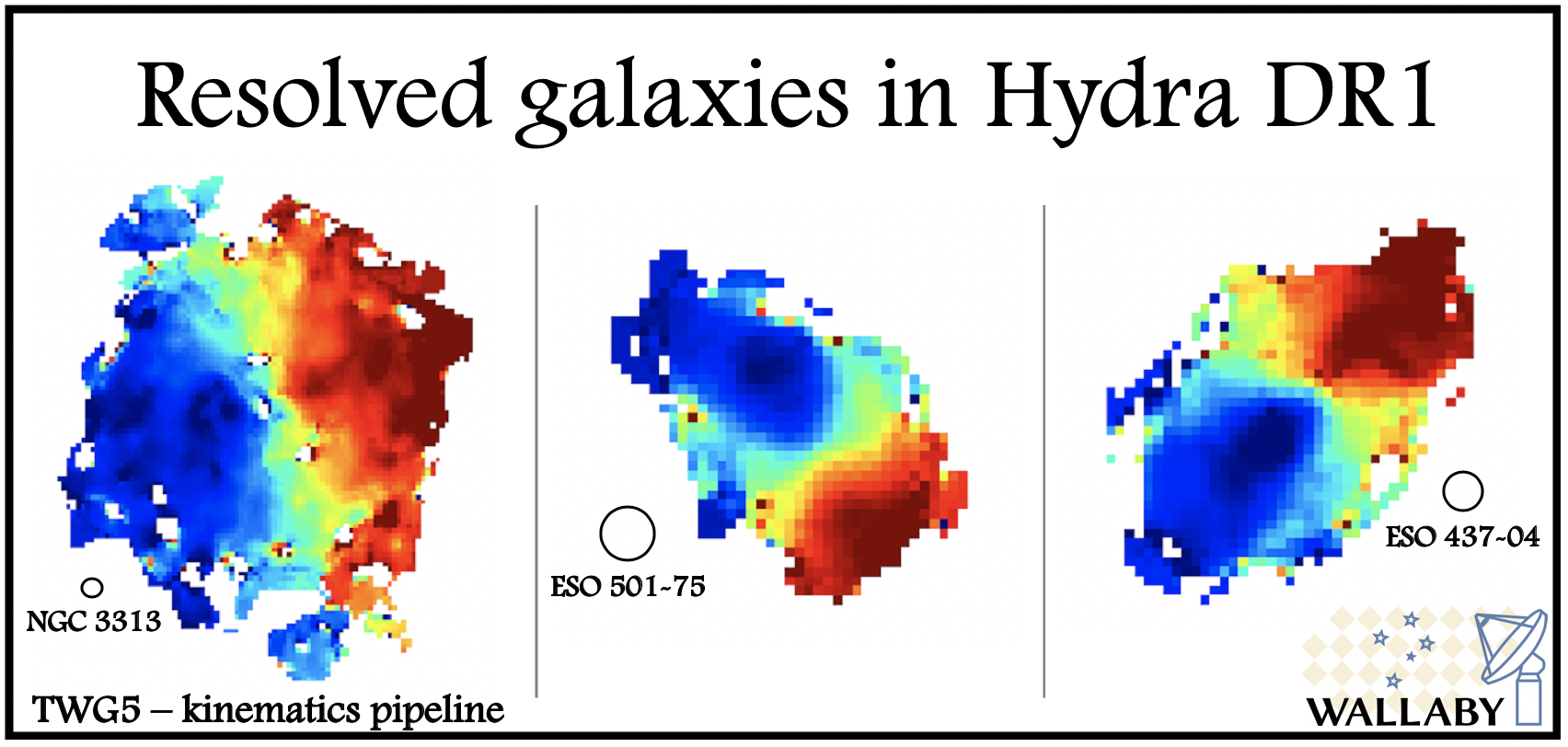
TWG 5 aims to begin distributing kinematic models to the WALLABY team by September 2020 in order to enable science: if you have a science case that requires a rotating disk model, please get in touch! In addition, WALLABY members who wish to join TWG 5 to contribute to this effort are always welcome. Regular updates regarding TWG 5 activities and meetings are posted on the WALLABY wiki. Stay tuned!
TWG 7 – Databases and Archiving
by Tristan Reynolds
With the start of the pilot survey comes the challenge of how to distribute and make the pilot survey (an eventually full survey) data accessible to the WALLABY team. With this in mind TWG 7 was formed to coordinate the efforts of the Australian SKA Regional Centre (AusSRC, Perth, Australia), the CSIRO ASKAP Science Data Archive (CASDA, Perth and Sydney, Australia), Canadian Initiative for Radio Astronomy Data Analysis (CIRADA, Toronto, Canada) and the SKA Regional Centre (SKA RC, Granada, Spain) in creating a WALLABY database. As the full 36 beam WALLABY cubes (e.g. the level 5/6 data products) are stored on CASDA, TWG 7 is focused on developing a database to hold level 7 data products. These include the output from SoFiA (TWG 4) and output from the kinematics pipeline being developed by TWG 5. The plan is for the database to also host ancillary multi-wavelength data crossmatched with WALLABY sources (SWG 5). We are currently working on a document detailing the data storage requirements for both the pilot survey and full WALLABY survey. Updates from the meetings and the activities of TWG 7 can be found on the WALLABY wiki.
SWG 1 – Galactic HI and High Velocity Clouds
by Helga Dénes and Bi-Qing For
SWG 1 focuses on projects related to Galactic HI and high velocity clouds. We have one formal approved pilot survey project with the goals of finding cold gas outside the Galactic Plane and studying its properties (led by H. Dénes). Calibrating and imaging the frequency range that contains the diffuse emission is particularly challenging. It requires a different approach as compared to processing data in the non-diffuse extragalactic frequency range. The reasons for this are: (i) the diffuse emission such as the Galactic HI emission is very bright, which the automated extragalactic flagging strategy tends to mistake for RFI, (ii) Galactic HI emission is very extended which means that to recover all the flux, imaging should be done with joint deconvolution for the whole field.
To solve the first issue, we adopted the flagging strategy as implemented by the GASKAP team. WALLABY project scientist, Karen Lee-Waddell, has helped processing one of the Hydra fields. The result is promising. Figures 6 and 7 show a moment 0 map of Galactic HI emission and an HI absorption spectra extracted against a background continuum source. We plan to test the joint deconvolution method for imaging the Galactic frequency range and to combine the ASKAP data with single dish data to recover the largest spatial scales of extended emission in the coming months.
We also have a wiki set up to facilitate the discussion. Access can be requested.
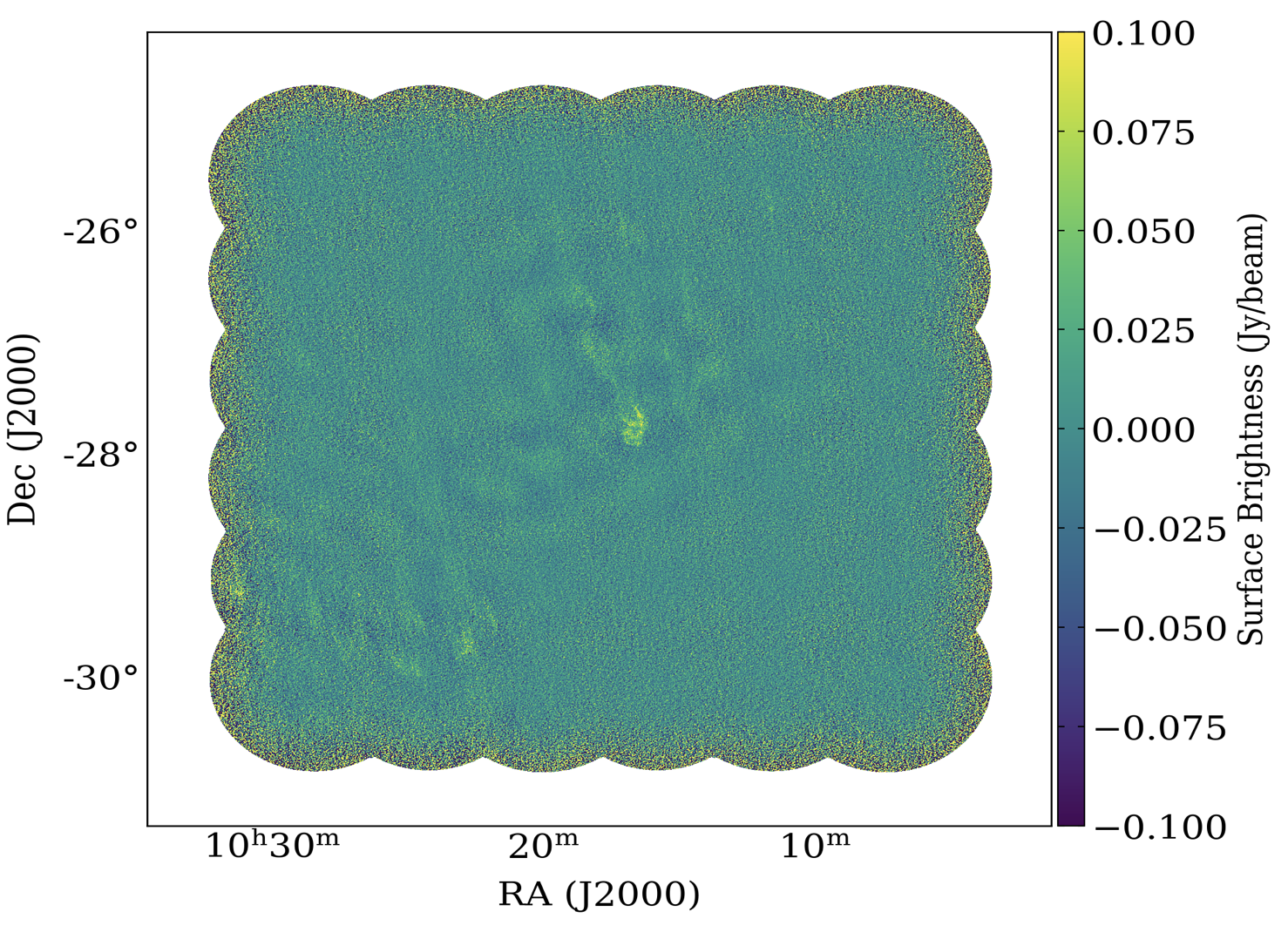
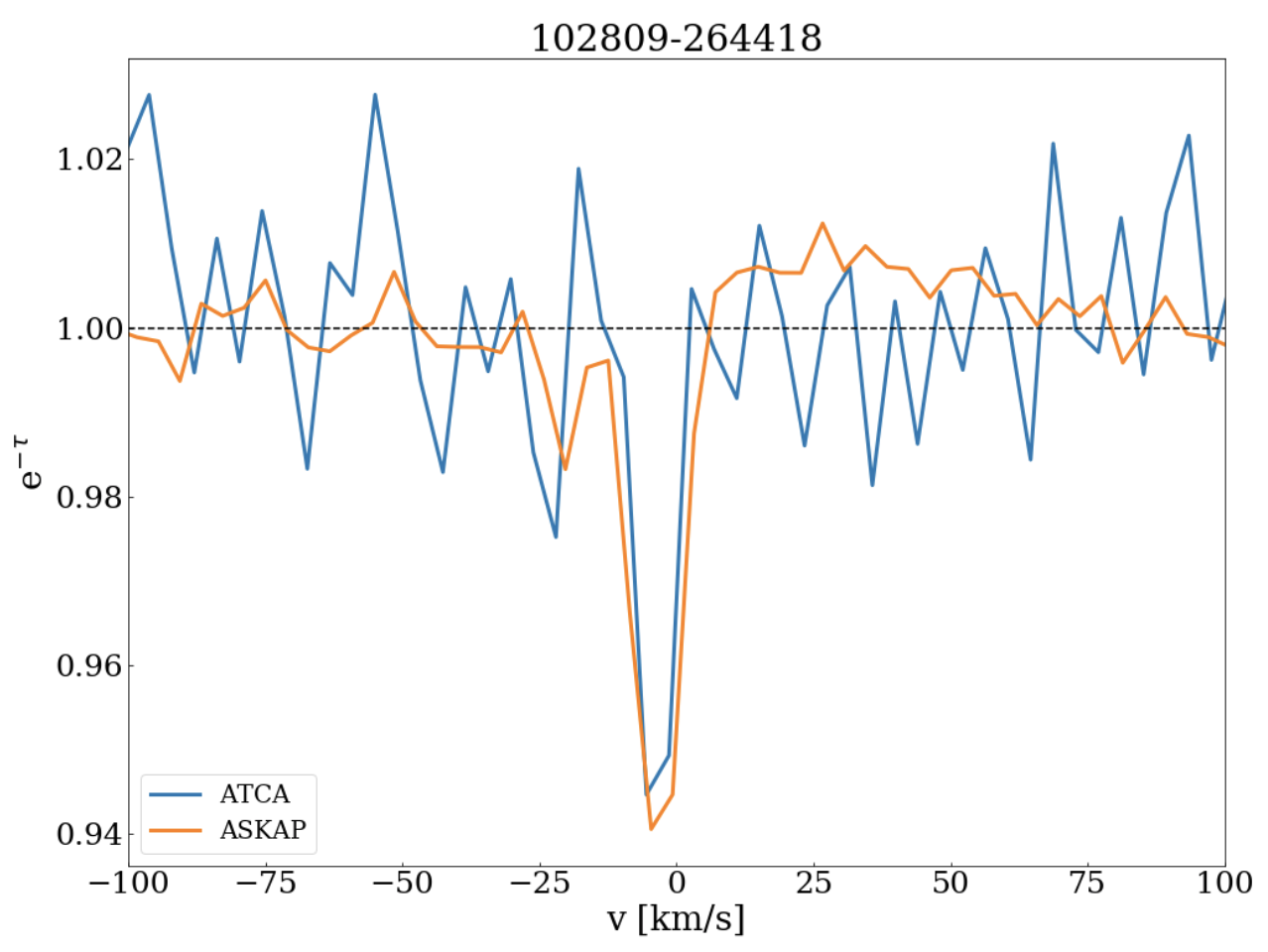
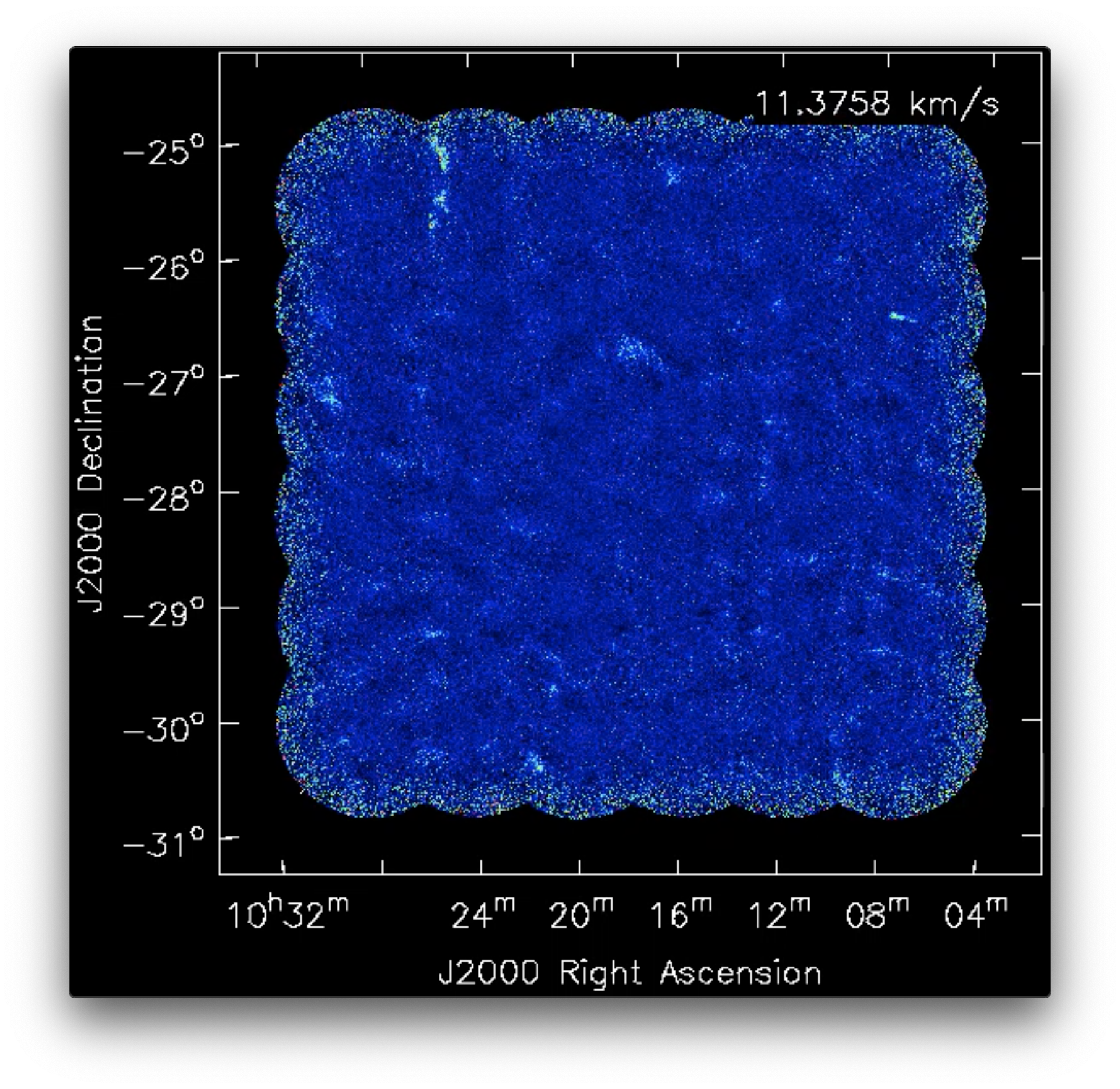
SWG 2 – Local Volume
by Se-Heon Oh and Ivy Wong
The two most regions of activity within the WALLABY SWG 2 team in the past 6 months revolves around the Eridanus early-science test observations and the internal DR1 release of the subregion within the pilot Hydra field.
Ten papers have been proposed for the Eridanus test observations and are currently in progress. There is an eleventh paper that is currently on hold because it is pending a positive outcome from the next round of telescope proposals using the Greenbank single-dish telescope. The purpose of these single-dish observations is to provide the necessary zero-spacing observations in order to recover the larger scale emission that may have been resolved out.
Since the February 2020, the WALLABY team has also seen the internal DR1 release of a subregion from the pilot Hydra field. Within SWG 2, we have 14 individual papers that are currently in discussion that are specific to the Hydra field. The team led by Se-Heon Oh has been examining HI properties of close galaxy pairs in the Hydra field as promising candidates which will or have experienced the merging process. Using a new profile decomposition tool, the so-called BAYGAUD, they have decomposed all the HI velocity profiles of the 22 resolved galaxies (3 of them are visually identified as galaxy pairs) from the Hydra DR1. Despite the small number statistics, a preliminary analysis shows a clear negative correlation between the galaxy halo mass (109 – 1012 M☉) and a ratio of the HI gas amount with different kinematic phases (e.g., Mass of cold HI gas / Mass of warm HI gas). The analysis will be also applied to the Hydra DR2 as well as other WALLABY pilot fields.
We expect to show more science results from these two fields in the next few months as the teams are currently busy working on their respective projects, so please stay tuned for future updates.
SWG 5 – Multi-wavelength and ASKAP Survey Synergies
by Luca Cortese and Li Shao
Following the first internal data release for the Hydra pilot field, there has been a lot of activity on the multi-wavelength front. SWG 5, in coordination with the WALLABY executive, is working on a plan to make sure that the efforts of the wider team on the creation of multi-wavelength value-added products is coordinated at the best of our abilities. More information will be provided very soon. In the meantime, if you haven’t already, please get in touch with us if you are either working on a multiwavelength data product or your science desperately requires multi-wavelength data that are not currently available.
WALLABY Publications
Jan 2020 – Aug 2020 (according to ADS):
- Koribalski, B., Staveley-Smith, L., Westmeier, T., Serra, P., Spekkens, K., Wong, O.I., Lagos, C.D.P. et al 2020, WALLABY – an SKA Pathfinder HI Survey, Astrophysics and Space Science, 365, 118
